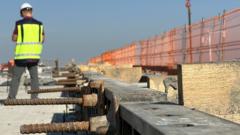**The completion of Rail Baltica, a transformative high-speed railway project linking Estonia, Latvia, and Lithuania, aims to bolster economic efficiency and bolster military mobility in the face of growing concerns over Russian aggression.**
**Baltics Ambitiously Push for Rail Baltica: A Strategic Imperative Amid Tensions with Russia**

**Baltics Ambitiously Push for Rail Baltica: A Strategic Imperative Amid Tensions with Russia**
**As the Baltic states expedite the Rail Baltica project, they look to enhance connectivity and security in light of regional threats.**
In response to mounting geopolitical tensions, the three Baltic states—Estonia, Latvia, and Lithuania—are invigorating their ambitions for the Rail Baltica project, a high-speed railway designed to span approximately 870 kilometers (540 miles) across the region. Initiated several years ago, the project has now evolved from a grand infrastructure idea into a crucial strategic necessity. In light of Russia's full-scale invasion of Ukraine, authorities in the Baltics increasingly regard their eastern neighbor as a substantial threat.
Currently, there is no rail connection linking the Baltics to Poland, making Rail Baltica an essential development for both economic integration and military readiness. As Estonia's Infrastructure Minister, Vladimir Svet, emphasized, the railway is critical against the backdrop of the ongoing Russian conflict. “History is repeating itself. Putin's aggressive regime is trying to recreate an imperial project in the former Soviet bloc,” he stated.
The memory of Soviet occupation remains vivid in the Baltics, where shared borders with Russia heighten security concerns. Notably, the Baltic nations host around 10,000 NATO troops, and this number could surge significantly in a crisis scenario.
“Rail Baltica will enhance military mobility, enabling swift travel from the Netherlands to Tallinn,” said Cmdr. Peter Nielsen from NATO's Force Integration Unit. For Estonia’s Minister of Infrastructure, the project represents “an unbreakable link with European networks.” Near the Estonian capital of Tallinn, construction is underway at the new Ülemiste passenger terminal, signaling progress on the railway, which will mark a significant departure from the former Soviet railway system that currently necessitates changing trains at the Polish border.
The new network will utilize the standard European railway gauge, drastically reducing travel times across the region—from Tallinn to Vilnius, for instance, the journey is expected to drop from over 12 hours to under four, with potential top train speeds of 250 km/h (155 mph).
The economic implications of the railway are projected to be substantial, with estimates suggesting an overall boost of approximately €6.6 billion (£5.5 billion). However, the rising costs of the project, now estimated at €24 billion—up from €6 billion in 2017—raise concerns among planners and officials. The EU has committed to funding 85% of the project and recently approved an additional €1.1 billion.
Critics argue that the Baltic states' focus on constructing terminals ahead of completing the railway itself could lead to inefficiencies. Emilien Dang, a French engineer overseeing the project, attributed rising costs to various disruptions, including the COVID-19 pandemic, inflation, and the war in Ukraine. He also highlighted complications arising from the project's tri-national nature, as each country maintains distinct regulations.
The Baltic states have opted to phase the project, with an initial €15 billion budget aimed at rolling out a single track by 2030. The completion of additional tracks and stations is proposed for a later phase with no set timeline. Concerns about securing sufficient funding for the first phase risk further delays.
Estonia's national auditor, Janar Holm, foresees that without immediate funding, the project could experience further setbacks. Nevertheless, Minister Svet remains committed to keeping costs in check and is open to securing loans if needed. He acknowledged the project’s vital role in preserving cultural identity and national security, emphasizing the necessity of a robust presence in the EU and NATO to uphold international norms.
For the Baltics—nations that once shed Soviet chains to embrace EU and NATO membership—Rail Baltica is more than just infrastructure: it’s a lifeline that carries the promise of connectivity, security, and resilience against an uncertain future.
Currently, there is no rail connection linking the Baltics to Poland, making Rail Baltica an essential development for both economic integration and military readiness. As Estonia's Infrastructure Minister, Vladimir Svet, emphasized, the railway is critical against the backdrop of the ongoing Russian conflict. “History is repeating itself. Putin's aggressive regime is trying to recreate an imperial project in the former Soviet bloc,” he stated.
The memory of Soviet occupation remains vivid in the Baltics, where shared borders with Russia heighten security concerns. Notably, the Baltic nations host around 10,000 NATO troops, and this number could surge significantly in a crisis scenario.
“Rail Baltica will enhance military mobility, enabling swift travel from the Netherlands to Tallinn,” said Cmdr. Peter Nielsen from NATO's Force Integration Unit. For Estonia’s Minister of Infrastructure, the project represents “an unbreakable link with European networks.” Near the Estonian capital of Tallinn, construction is underway at the new Ülemiste passenger terminal, signaling progress on the railway, which will mark a significant departure from the former Soviet railway system that currently necessitates changing trains at the Polish border.
The new network will utilize the standard European railway gauge, drastically reducing travel times across the region—from Tallinn to Vilnius, for instance, the journey is expected to drop from over 12 hours to under four, with potential top train speeds of 250 km/h (155 mph).
The economic implications of the railway are projected to be substantial, with estimates suggesting an overall boost of approximately €6.6 billion (£5.5 billion). However, the rising costs of the project, now estimated at €24 billion—up from €6 billion in 2017—raise concerns among planners and officials. The EU has committed to funding 85% of the project and recently approved an additional €1.1 billion.
Critics argue that the Baltic states' focus on constructing terminals ahead of completing the railway itself could lead to inefficiencies. Emilien Dang, a French engineer overseeing the project, attributed rising costs to various disruptions, including the COVID-19 pandemic, inflation, and the war in Ukraine. He also highlighted complications arising from the project's tri-national nature, as each country maintains distinct regulations.
The Baltic states have opted to phase the project, with an initial €15 billion budget aimed at rolling out a single track by 2030. The completion of additional tracks and stations is proposed for a later phase with no set timeline. Concerns about securing sufficient funding for the first phase risk further delays.
Estonia's national auditor, Janar Holm, foresees that without immediate funding, the project could experience further setbacks. Nevertheless, Minister Svet remains committed to keeping costs in check and is open to securing loans if needed. He acknowledged the project’s vital role in preserving cultural identity and national security, emphasizing the necessity of a robust presence in the EU and NATO to uphold international norms.
For the Baltics—nations that once shed Soviet chains to embrace EU and NATO membership—Rail Baltica is more than just infrastructure: it’s a lifeline that carries the promise of connectivity, security, and resilience against an uncertain future.




















